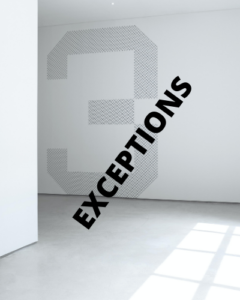Should I make eye contact with the interpreter or consumer?
Sometimes it’s hard to know whether to look at the interpreter or the person who needs the interpreter (the consumer). Here, I will tell you everything you need to know about avoiding eye contact with the interpreter, how, why, and the 3 exceptions when it’s okay.
Managing eye contact with the interpreter
Here’s the rule: when in doubt, ignore the interpreter. Don’t worry! You won’t hurt their feelings. In fact, interpreters are pretty used to being invisible.
In most cases, professional interpreters know what is at stake when your attention isn’t geared towards the consumer. For starters, you don’t create a human connection. This is important because connecting with someone who doesn’t use the same language can be hard enough as it is.
Luckily, when you ignore the interpreter, your attention has only one place to go – to the consumer. As a result, the consumer feels a more personal connection with you, rather than the interpreter.
This helps you create a more natural connection with people who have language barriers. In the end, making the conversation more smooth and genuine for everyone.
Easier said than done though, right?
Here’s a trick to help you create a solid connection with the consumer, every time.
Speak in the first-person to avoid eye contact with the interpreter
Speaking in the first person is a great way to keep the conversation between you and the consumer. Here’s a quick example of speaking in the first person when using interpreters, and why it makes a difference.
Speaking in the first person when using interpreters
If I had my shirt on backwards, you might say to me in the first person, “hey, I think your shirt is on backwards.” I would then blush, thank you, and probably fix my shirt.
What if I didn’t speak English though, and you needed an interpreter to tell me about my shirt? Surprisingly, the sentence doesn’t need to change.
Instead of telling the interpreter, “tell him I think his shirt is on backwards,” the trick is to ignore the interpreter, and still say, “hey, I think your shirt is on backwards.”
This way, the interpreter can remove themself from the conversation as much as possible. In turn, allowing them to deliver your message to the consumer as if it were coming directly from you.
Benefits of speaking in the first person
When it comes to interpreting, speaking in the first person is a pretty standard rule. While there are a few reasons why speaking in the first person is a good practice to remember, here are the big three.
1. Speaking in the first person helps everyone understand their role when using an interpreter.
Since the interpreter and consumer speak the same language, it’s not uncommon for the consumer to want to focus on the interpreter. However, speaking in the first person can lighten this effect. Mainly, because it removes the interpreter from the context, making everyone’s role in the conversation clear.
2. First-person speech ensures a clear and accurate message is being delivered.
Speaking in the first person makes it clear to the consumer that the interpreter is not the source of the statement. When the consumer understands this, they are receiving the most accurate rendition of your message possible.
Speaking in the first-person promotes a more efficient exchange of information.
Using the first person makes it easier for the interpreter to render your message. By doing so, you and the interpreter get to cut out all the “he said / she said” stuff. In turn, this makes the conversation much faster and less confusing.
3 exceptions for making eye contact with the interpreter
On the other hand, there are those times when you just can’t help but look at the interpreter. Don’t get me wrong. It’s okay to glance back and forth between the interpreter and the consumer. In fact, there are situations where you don’t have much of a choice. Let’s look at the 3 exceptions for making eye contact with the interpreter.
1. Verification
I just want to make sure…
You or the interpreter may ask for verification if you are not sure what was said. Frequently, this happens with numbers, names, and addresses.
For example, if you tell the interpreter, “the phone number is 555-2234”, the interpreter might say, “I (the interpreter) want to make sure I heard the number right. Ma’am, did you say 555-2234?”. If the interpreter misheard, feel free to repeat, or turn to them and directly verify what was said. This is a great way to make sure everyone gets the right message.
2. Clarification
What does that mean?

An interpreter will request clarification if they don’t know what a word or term means. In the following scenario, it’s almost impossible not to interact with the interpreter.
While interpreting for a patient with a common cold, the interpreter says, “Nurse, I’m not sure what you mean by rhinorrhea. Could you clarify?” In this case, the nurse has to turn to the interpreter and explain that “rhinorrhea” means a “runny nose.” After clarifying, the interpreter will be able to ensure the consumer understands the message.
3. Side Note
I would like to add…
You might also hear an interpreter add a side note. Side-notes are a great way to avoid potential problems. The reason sidenotes are helpful to you, the consumer, and the interpreter, is because they offer information that may not be noticed otherwise.
For example, the interpreter might say, “Ma’am, this is the interpreter speaking and as a side note, the person doesn’t know what Medicaid means. Could you briefly explain?” In this case, the interpreter is adding a side note to avoid confusion. Sometimes you and the interpreter might have to briefly work together to make sure everyone is on the same page.
Keeping the connection alive through eye contact
Good eye contact is the cornerstone of any important conversation. Which is why making good eye contact with the consumer is so important. By keeping your gaze in the right place, you’ll be one step closer to replacing your language barrier with a meaningful connection.
Still have questions? Feel free to talk to a professional at Hands Up Communications to learn more about working with interpreters.
[ABTM id=1966]



